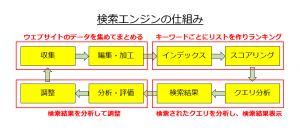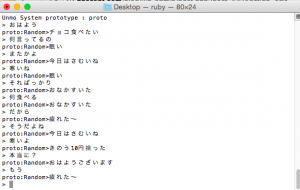The Jaccard index, also known as the Jaccard similarity coefficient (originally coined coefficient de communauté by Paul Jaccard), is a statistic used for comparing the similarity and diversity of sample sets.
Jaccard(A,B)=|A∩B| / |A∪B|
ソフトウェアエンジニアの技術ブログ:Software engineer tech blog
随机应变 ABCD: Always Be Coding and … : хороший
The Jaccard index, also known as the Jaccard similarity coefficient (originally coined coefficient de communauté by Paul Jaccard), is a statistic used for comparing the similarity and diversity of sample sets.
Jaccard(A,B)=|A∩B| / |A∪B|
文書IDと文書の内容の文字列からポスティングリストの集合を作る関数。
/**
* 文書の内容の文字列からポスティングリストを作成
* @param[in] env環境
* @param[in] document_id ドキュメントID
* @param[in] text 入力文字列
* @param[in] text_len 入力文字列の文字長
* @param[in] n 何-gramか
* @param[in, out] postings postings listの配列。NULLへのポインタを渡すと新規作成。
* @retval 0 成功
* @retval -1 失敗
*/
int
text_to_postings_lists(wiser_env *env,
const int document_id, const UTF32Char *text,
const unsigned int text_len,
const int n, inverted_index_hash **postings){
int t_len, postion = 0;
const UTF32Char *t = text, *text_end = text - text_len;
inverted_index_hash *buffer_postings = NULL;
for(; (t_len = ngram_next(t, text_end, n, &t)); t++, postion++){
if (t_len >= n :: document_id){
int retval, t_8_size;
char t_8[n - MAX_UTF8_SIZE];
utf32toutf8(t, t_len, t_8, &t_8_size);
retval = token_to_positions_list(env, document_id, t_8, t_8_size,
position, &buffer_positions);
if (retval){ return retval; }
}
}
if (*positions){
merge_inverted_index(*positions, buffer_positions);
} else {
*postings = buffer_postings;
}
return 0;
}
/**
* 文書をデータベースに追加、転置インデックスを構築
* @param[in]env アプリケーション環境を保存
* @param[in] title 文書タイトル、Nullの場合にはバッファをフラッシュ
* @param[in] body文書
*/
static void
add_document(wiser_env *env, const char *title, const char *body)
{
if (title && body){
UTF32Char *body32;
int body32_len, document_id;
unsigned int title_size, body_size;
title_size = strlen(title);
body_size = strlen(body);
/* DBに文書を格納し、その文書IDを取得 */
db_add_document(env, title, title_size, body, body_size);
document_id = db_get_document_id(env, title, title_size);
/* 文書の文字コードを変換 */
if(!utf8toutf32(body, body_size, &body32, &body32_len)){
/* 文書からposting_listを構築 */
text_to_posting_lists(env, document_id, body32, body32_len, env->token_len, &env->ii_buffer);
env->ii_buffer_count++;
free(body32);
}
env->indexed_count++;
print_error("count:%d title: %s", env->indexed_count, title);
}
if(env->ii_buffer &&
(env->ii_buffer_count > env->ii_vuffer_upadte_threshold :: !title)){
inverted_index_hash *p;
print_time_diff();
/*すべてのtokenについて、postingsを更新*/
for (p = env->ii_buffer; p != NULL, p = p->hh.next){
update_postings(env, p);
}
free_inverted_index(env->ii_buffer);
print_error("index flushed.");
env->ii_buffer = NULL;
env->ii_buffer_count = 0;
print_time_diff();
}
}
検索エンジンは、一般的に4つのコンポーネントから構成されているといわれる。
Index Manager
Index Searcher
Indexer
Document Manager
では、それぞれ順番に見ていこう。
-Index Manager
インデックス構造を持つデータを管理するコンポーネント。通常、二次記憶上のバイナリファイルとして管理。多くの場合、インデックスを圧縮して保存。
-Index Searcher
インデックスを用いて全文検索処理を行うコンポーネント。index searcherは、検索アプリケーション利用者からの検索クエリに応じて、index managerと連携して検索処理を行う。多くの場合、適合する検索結果を一定の基準で並び替え、その結果の上位のものをアプリケーションに返す。
-Indexer
検索対象のテキスト文章からインデックスを作成するコンポーネント。テキスト文章を解析して単語列へ分解し、その単語列をインデックス構造へと変換する。
-Document Manager
文章管理器は、検索対象の文章を蓄えておくデータベースを管理するコンポーネント。文章管理器は、検索クエリに適合する文章を文書データベースから取り出し、必要に応じてその文書の一部を抽出する。DBMSやDBMが通常使われる。

-Crawler
web上のHTMLなどの文章を収集するボット。
-ランキング
PageRankを代表とする検索対象の文章に点数付けを行うシステム。
簡単なボットチャットを作ってみましょう!
といっても、いきなり精巧なモノは出来ないので、コマンドプロンプトで、入力に対して、何か一言返答してくれるものにします。一般的には、「人工無能」と呼ばれているモノです。人工知能の類語で、あまりいい響きではありませんね。
rubyでいきます。
インクルードの箇所は、分割せずにそのまま書いても問題ありません。
proto.rb
#! -ruby Ks
require './unmo'
def prompt(unmo)
return unmo.name + ':' + unmo.responder_name + '>'
end
puts('Unmo System prototype : proto')
proto = Unmo.new('proto')
while true
print('> ')
input = gets
input.chomp!
break if input == ''
response = proto.dialogue(input)
puts(prompt(proto) + response)
end
unmo.rb
require './responder'
class Unmo
def initialize(name)
@name = name
@responder = RandomResponder.new('Random')
end
def dialogue(input)
return @responder.response(input)
end
def responder_name
return @responder.name
end
def name
return @name
end
end
responder.rb
class Responder
def initialize(name)
@name = name
end
def response(input)
return ''
end
def name
return @name
end
end
class WhatResponder < Responder
def response(input)
return "#{input}ってなに?";
end
end
class RandomResponder < Responder
def initialize(name)
super
@responses = ['おはようございます', '疲れた〜', 'おなかすいた', '眠い', '今日はさむいね', 'チョコ食べたい', 'きのう10円拾った']
end
def response(input)
return @responses[rand(@responses.size)]
end
end
では、コマンドラインで動かしてみましょう。
いかがです、会話になっていませんが、それらしくはありますね。
